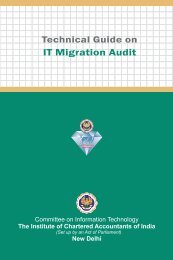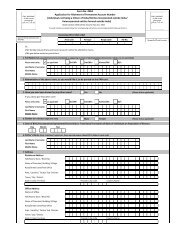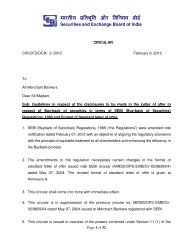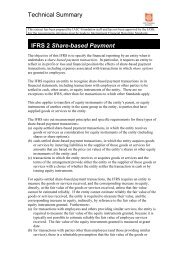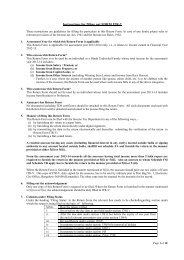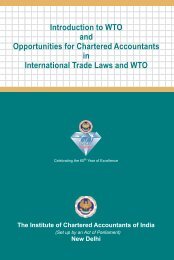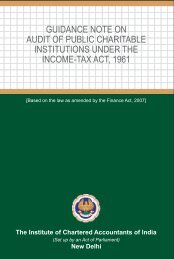Instructions for filling out FORM ITR-4 - CAalley.com
Instructions for filling out FORM ITR-4 - CAalley.com
Instructions for filling out FORM ITR-4 - CAalley.com
- No tags were found...
You also want an ePaper? Increase the reach of your titles
YUMPU automatically turns print PDFs into web optimized ePapers that Google loves.
(w) Schedule AMTC: Computation of tax credit under section 115JD.(x) Schedule SPI: Statement of in<strong>com</strong>e arising to spouse/ minor child/ son’s wife or any otherperson or association of persons to be included in the in<strong>com</strong>e of assessee in Schedules-HP,BP, CG and OS.(y) Schedule-SI: Statement of in<strong>com</strong>e which is chargeable to tax at special rates.(z) Schedule-IF: In<strong>for</strong>mation regarding partnership firms in which assessee is a partner.(aa) Schedule-EI: Statement of In<strong>com</strong>e not included in total in<strong>com</strong>e (exempt in<strong>com</strong>es).(bb) Schedule-IT: Statement of payment of advance-tax and tax on self-assessment.(cc) Schedule-TDS1: Statement of tax deducted at source on salary.(dd) Schedule-TDS2: Statement of tax deducted at source on in<strong>com</strong>e other than salary.(ee) Schedule-TCS: Statement of tax collected at source.(ff) Schedule-FSI: Details of In<strong>com</strong>e accruing or arising <strong>out</strong>side India.(gg) Schedule-TR: Statement of tax relief claimed under section 90 or section 90A or section 91.(hh) Schedule-FA: Statement of Foreign Assets.(ii) Schedule-5A: Statement of apportionment of in<strong>com</strong>e between spouses governed byPortuguese Civil Code.(jj) Schedule-AL: Statement of your Asset and Liability at the end of the year. It is mandatory ifyour total in<strong>com</strong>e exceeds Rs. 25 lakh.10. GUIDANCE FOR FILLING OUT PARTS AND SCHEDULES(1) General(i) All items must be filled in the manner indicated therein; otherwise the return maybe liable to be helddefective or even invalid.(ii) If any schedule is not applicable score across as “---NA---“.(iii) If any item is inapplicable, write “NA” against that item.(iv) Write “Nil” to denote nil figures.(v) Except as provided in the <strong>for</strong>m, <strong>for</strong> a negative figure/ figure of loss, write “-” be<strong>for</strong>e such figure.(vi) All figures should be rounded off to the nearest one rupee. However, the figures <strong>for</strong> total in<strong>com</strong>e/ lossand tax payable be finally rounded off to the nearest multiple of ten rupees.(2) Sequence <strong>for</strong> <strong>filling</strong> <strong>out</strong> parts and schedules(i) Part A(ii) Schedules(iii) Part B(iv) Verification(v) Details relating to TRP and counter signature of TRP if return is prepared by him.11. PART A-GENMost of the details to be filled <strong>out</strong> in Part-Gen of this <strong>for</strong>m are self-explanatory. However, some of the detailsmentioned below are to be filled <strong>out</strong> as explained hereunder:-(a) Taxpayers are advised to mandatorily fill up the address columns carefully and provide correct in<strong>for</strong>mation.Similarly status column needs to be filled mandatorily.(b) Tax payers are advised to furnish their correct mobile number and e-mail address so as to facilitate theDepartment in sending updates relating to demand, refund etc. In case a return is filed by anintermediary/professional, the email address of the intermediary as well as the assessee may be provided.(c) In case of an individual, <strong>for</strong> “employer category”, Government category will include Central Government/State Governments employees. PSU category will include public sector <strong>com</strong>panies of Central Government andState Government;(d)(e)The code <strong>for</strong> sections under which the return is filed be filled as per code given in instruction No.6(i).In case the return is being filed by you in a representative capacity, please ensure to quote your PAN in item“PAN of the representative assessee”. In case the PAN of the person being represented is not known or he hasnot got a PAN in India, the item <strong>for</strong> PAN in the first line of the return may be left blank. It may please be notedthat in the first line of this <strong>for</strong>m, the name of the person being represented be filled.12. PART A-BS AND PART A-P&L(a) The Balance Sheet as on 31st March, 2013 and the profit and loss account <strong>for</strong> financial year 2012-13 in the<strong>for</strong>mats provided in these parts have to be filled in respect of proprietory business or profession carried <strong>out</strong> byyou during the financial year 2012-13 if you were required to maintain accounts of the business or professionduring the year.(b) If the matters other than proprietory business are not being accounted <strong>for</strong> in the books of the proprietorybusiness or profession, these need not to be included in the balance sheet and profit and loss account to be filledin this Part.Page 6 of 14
(c)(d)In case, accounts of the business or profession were required to be audited, the items of balance sheet andprofit and loss account filled in the these parts should broadly match with the audited balance sheet and profitand loss account.In case, you were not required to maintain accounts of the business or profession during the year, please fill <strong>out</strong>the details mentioned in these parts against portion ‘No account case’.13. PART A- OI AND PART A-QD(a) If the accounts of the business or profession were not required to be audited under section 44AB, it is optionalto fill these parts.(b) Where the accounts of the business or profession were required to be audited under section 44AB, the details tobe filled in these parts which are also required to be reported in the report of audit by the auditors, shouldbroadly match with the details as given in the report of audit.(c) Purchases are to be shown exclusive of taxes and the details of taxes paid on the purchases are to be indicatedseparately in the relevant rows. However, where it is not possible to segregate the details of the different taxespaid on the purchases, the same may be included and shown in the details of purchases.(d) In Part A-QD, the quantitative details may be furnished only in respect of principal items.14. SCHEDULES(a) Schedule-S-In case there were more than one employer during the year, please give the details of the lastemployer. Further, in case, there were more than one employer simultaneously during the year, pleasefurnish the details of the employer you have got more salary. Fill the details of salary as given in TDScertificate(s) (Form 16) issued by the employer(s). However, if the in<strong>com</strong>e has not been <strong>com</strong>puted correctlyin Form No. 16, please make the correct <strong>com</strong>putation and fill the same in this item. Further, in case therewere more than one employer during the year, please furnish in this item the details in respect of totalsalaries from various employers.(b) Schedule-HP,-In case, a single house property is owned by the assessee which is self-occupied and interestpaid on the loan taken <strong>for</strong> the house property is to be claimed as a deduction. This schedule needs to befilled up. The in<strong>for</strong>mation relating to the percentage of share of the assessee in the co-owned property ismandatory. In case the property is co-owned then the assessee needs to furnish the name of the co-owner,PAN and percentage of share of the other co-owner (s) in the property. However the details of PAN andpercentage of share of other co-owner (s) is optional. If there are more than three house properties, thedetails of remaining properties be filled in a separate sheet in the <strong>for</strong>mat of this Schedule and attach thissheet with this return. The results of the in<strong>com</strong>e/ loss derived from all the properties have to be filled in lastrow of this Schedule. Following points also need to be clarified,-(i) Annual letable value means the amount <strong>for</strong> which the house property may reasonably be expected tolet from year to year, on a notional basis: Deduction <strong>for</strong> taxes paid to local authority shall be availableonly if the property is in the occupation of a tenant, and such taxes are borne by the assessee and notby the tenant and have actually been paid during the year.(ii) In case of self-occupied property 1e shall be nil and interest payable on borrowed capital under 1gshall be limited to Rs. 1, 50,000/-.(iii) Deduction is available <strong>for</strong> unrealized rent in the case of a let-<strong>out</strong> property. If such a deduction hasbeen taken in an earlier assessment year, and such unrealized rent is actually received in theassessment year in question, the unrealized rent so received is to be shown in item 4a of this Schedule.(iv) Item 4b of this Schedule relates to enhancement of rent with retrospective effect. Here mention backyears’ extra rent received thereon, and claim deduction @ 30% of such arrear rent received.(c) Schedule-BP,-(i) The <strong>com</strong>putation in this schedule has to be started on the basis of profit be<strong>for</strong>e tax as shown in item43 of Part-A- P&L.(ii) In case any item of addition or deduction not covered by the items mentioned in this schedule be filledin residual items 21 and 26 of this schedule.(iii) In case accounts of business or profession are not maintained, the profit as entered into by you in item50d of Part A-P&L.(iv) In case, agricultural in<strong>com</strong>e to be excluded on the basis of rule 7A, 7B or 7C (in business of growingand manufacturing tea, coffee etc), it shall not be included in the item 5c of this schedule.(v) In A-37, net profit or loss from business or profession is to be <strong>com</strong>puted, only in special cases, e.g.business of growing and manufacturing tea, coffee, etc., where rules 7A, 7B or 7C is applicableotherwise, the figure of profit/ loss as <strong>com</strong>puted is A-36 may be entered.(vi) In<strong>com</strong>e earned by the assessee by way of salary, <strong>com</strong>mission, bonus, interest, etc. from other firms asif in the capacity of a partner, which has not been included in the profit and loss account of theproprietory business needs to be disclosed in item No. A23 in Schedule BP.(vii) Item D of this schedule <strong>com</strong>putes the total of profit or loss from business or profession (other thanspeculative business and specified business and profit or loss from speculative business and profit orPage 7 of 14
loss of specified business) (item A37 + item B41 + item C44). Please note that if balance in item B41in respect of speculative business is a loss, same shall not be set-off against profit from nonspeculativebusiness. Similarly if balance in item C44 in respect of specified business is a loss, sameshall not be set off against profit from non-specified business. In such situation, only the figures ofitem A37 be entered in item D.(d) Schedule-DPM, Schedule DOA, Schedule DEP and Schedule DCG,-For sake of convenience, <strong>com</strong>putation ofdepreciation allowable under the In<strong>com</strong>e-tax Act [other than in case of an undertaking generating electricitywhich may at its option claim deprecation on straight line method under section 32(1)(i)], has been divided intotwo parts i.e. in schedules DPM (depreciation on plant and machinery )and DOA (depreciation on other assets).The summery of depreciation as per these schedules has to be shown in schedule DEP. Deemed short term capitalgain, if any as <strong>com</strong>puted in schedule DPM and DOA has to be entered into schedule DCG.(e) Schedule ESR: Deduction under section 35 (expenditure on scientific research),-In column (2) of thisschedule, please furnish the details of deduction to which you are entitled under provisions of this section. Incolumn (1), please enter the amounts of expenses of the nature covered by section 35 which are, if, debited toprofit and loss account. Please note that no deduction <strong>for</strong> depreciation is available in respect of capital asset <strong>for</strong>which deduction under section 35(1)(iv) has been claimed.(f) Schedule-CG,-(i) If more than one short-term capital asset has been transferred, make the <strong>com</strong>bined <strong>com</strong>putation <strong>for</strong> allthe assets. However, in case of transfer of an equity share in a <strong>com</strong>pany or a unit of an equity orientedfund, being a short-term capital asset, where Securities Transaction Tax has been paid on suchtransfer, the <strong>com</strong>putation should be in column 3 under Short-term capital gain. Similarly, make the<strong>com</strong>bined <strong>com</strong>putation <strong>for</strong> all the assets if more than one long-term capital asset has been transferred.However, in case of transfer of a long-term capital asset, being listed securities or unit or zero couponbonds where the tax payable exceeds ten percent of the capital gains be<strong>for</strong>e indexation, then theexcess shall be ignored and the <strong>com</strong>putation shall be filed <strong>out</strong> in column 3 under Long-term capitalgains.(ii) For <strong>com</strong>puting long-term capital gain, cost of acquisition and cost of improvement may be indexed, ifrequired, on the basis of following cost inflation index notified by the Central Government <strong>for</strong> thispurpose.Sl.No. Financial Year Cost InflationIndexSl.No. FinancialYearCost InflationIndex1. 1981-82 100 16. 1996-97 3052. 1982-83 109 17. 1997-98 3313. 1983-84 116 18. 1998-99 3514. 1984-85 125 19. 1999-00 3895. 1985-86 133 20. 2000-01 4066. 1986-87 140 21. 2001-02 4267. 1987-88 150 22. 2002-03 4478. 1988-89 161 23. 2003-04 4639. 1989-90 172 24. 2004-05 48010. 1990-91 182 25. 2005-06 49711. 1991-92 199 26. 2006-07 51912. 1992-93 223 27. 2007-08 55113. 1993-94 244 28. 2008-09 58214. 1994-95 259 29. 2009-10 63215. 1995-96 281 30. 2010-11 71131. 2011-12 785 32. 2012-13 852(iii)Sections 54/54B/54D/54EC/54F/54G/54GA/54GB mentioned in this schedule provides exemption oncapital gains subject to fulfillment of certain conditions. Exemption under some of these sections isavailable only in respect of long-term capital gains. There<strong>for</strong>e, please ensure that you are claiming thebenefit of any of these sections correctly in accordance with the provisions of law. In case of claim ofdeduction u/s 54GB, PAN of the eligible <strong>com</strong>pany is to be mandatorily provided.(iv)(g) Schedule-OS,-(i)Item C of this Schedule <strong>com</strong>putes the total of short-term capital gain and long-term capital gain (itemA6 + item B6). Please note that if balance in item B6 in respect of long-term capital gain is a loss,same shall not be set-off against short-term capital gain. In such situation, the figure of item B6 wouldbe entered as 0 and then the figures of item A6 be added in item C.Against item 1a and 1b, enter the details of gross in<strong>com</strong>e by way of dividend and interest which isnot exempt.Page 8 of 14
(ii) Against item 1c, indicate the gross in<strong>com</strong>e from machinery, plant or furniture let on hire and alsosuch in<strong>com</strong>e from building where its letting is inseparable from the letting of the said machinery,plant or furniture, if it is not chargeable to in<strong>com</strong>e-tax under the head “Profits and gains of business orprofession”.(iii) In<strong>com</strong>e from owning and maintaining race horses is to be <strong>com</strong>puted separately as loss from owningand maintaining race horses cannot be adjusted against in<strong>com</strong>e from any other source, and can only becarried <strong>for</strong>ward <strong>for</strong> set off against similar in<strong>com</strong>e in subsequent years.(iv) Winnings from lotteries, crossword puzzles, races, games, gambling, betting etc., as per section115BB are to be entered on gross basis and are subject to special rates of tax; hence a separate item isprovided and the in<strong>com</strong>e from these cannot be adjusted against the losses arising under the headIn<strong>com</strong>e from other sources.(v) Item 5 of this Schedule <strong>com</strong>putes the total in<strong>com</strong>e chargeable under the head “In<strong>com</strong>e from othersources” (item 1g + item 2 + item 3 + item 4c). If balance in item 4c from owning and maintainingrace horses is a loss, please enter 0 and enter the total of item 3 in item 5 only.(h) Schedule-CYLA,-(i)(ii)Mention only positive in<strong>com</strong>es of the current year in column 1, headwise, in the relevant rows.Mention total current year’s loss(es), if any, from house property, business or profession and othersources (other than losses from race horses) in the first row against the heading loss to be adjustedunder the respective head. These losses are to be set off against in<strong>com</strong>e under other heads inaccordance with the provisions of section 71. The amount set off against the in<strong>com</strong>e of respectiveheads has to be entered into in columns 2, 3 and 4, in the relevant rows.(iii) Mention the end-result of the above inter-head set-off(s) in column 5, headwise, in relevant rows.(iv) Total of loss set off <strong>out</strong> of columns 2, 3 and 4 have to be entered into row x.(v) The losses remaining <strong>for</strong> set off have to be entered in row xi.(i) Schedule-BFLA,-(i) Mention only positive in<strong>com</strong>es of the current year (after set-off of loss in Schedule-CYLA in column1, headwise in relevant rows.(ii) The amount of brought <strong>for</strong>ward losses which may be set off are to be entered in column 2 inrespective rows.(iii) The end result of the set off will be entered in column 3 in respective heads. The total of column 3(iv)shall be entered in row ix which shall give the amount of gross total in<strong>com</strong>e.The total amount of brought <strong>for</strong>ward losses set off during the year shall be entered in column 2 of rowix.(j) Schedule-CFL,-(i) In this Schedule, the summary of losses carried from earlier years, set off during the year and to becarried <strong>for</strong>ward <strong>for</strong> set off against in<strong>com</strong>e of future years is to be entered.(ii) The losses under the head “house property”, ‘profit and gains of business or profession” short termcapital loss and long term capital loss, are allowed to be carried <strong>for</strong>ward <strong>for</strong> 8 years. However, lossfrom owning and maintaining race horses can be carried <strong>for</strong>ward only <strong>for</strong> 4 assessment years.(k) Schedule-UD,-In this Schedule, amount of brought <strong>for</strong>ward unabsorbed depreciation <strong>for</strong> each assessment year,amount of depreciation set-off against the current year’s in<strong>com</strong>e and the balance unabsorbed depreciation to becarried <strong>for</strong>ward to the next assessment year needs to be mentioned.(l) Schedule- 10A,-(i)(ii)If there are more than one undertaking entitled <strong>for</strong> deduction under this section, please enter thedetails of deduction <strong>for</strong> each undertaking separately.The amount of deduction under this section <strong>for</strong> an undertaking shall be as per item 17 of Form No.56Fbeing the report of audit under section 10A.(m) Schedule-10AA,-If there are more than one undertaking entitled <strong>for</strong> deduction under this section, please enter thedetails of deduction <strong>for</strong> each undertaking separately.(n) Schedule- 80G,-(i) In this Schedule, the details of donation given by you which are entitled <strong>for</strong> deduction under section80G have to be filled.(ii) In part-A of this Schedule, the details of donations which are entitled <strong>for</strong> 100% deduction with<strong>out</strong> aqualifying limit are to be filled in.(iii) In Pat-B of this Schedule, the details of donations which are entitled <strong>for</strong> 50% deduction with<strong>out</strong> aqualifying limit are to be filled in.(iv) In Part-C of this Schedule, the details of donations which are entitled <strong>for</strong> 100 % deduction subject toqualifying limit are to be filled in.(v) In Part- D of this Schedule, the details of donations which are entitled <strong>for</strong> 50% deduction subject toqualifying limit are to be filled in.(o) Schedule- 80IA, Schedule- 80IB, Schedule- 80IC and Schedule-80-IE -(i)If there are more than one undertaking entitled <strong>for</strong> deduction under any of these sections, please enterthe details of deduction in relevant schedule <strong>for</strong> each undertaking separately.Page 9 of 14
(ii)The amount of deduction <strong>for</strong> an undertaking shall be as per item 30 of Form No.10CCB being thereport of audit under section 80-IA/ 80-IB/ 80-IC and 80-IE.(p) Schedule-VIA,-(i)The total of the deductions allowable is limited to the amount of gross total in<strong>com</strong>e. For details ofdeductions allowable, the provisions of the Chapter VI-A may kindly be referred to.(ii) For deductions under sections 80-IA, 80-IB, 80-IC and 80-IE the amount as shown in Schedules 80-IA, 80-IB and 80-IC be filled. The amount of deduction to be claimed under section 80-ID may beshown in this Schedule itself.(iii)Details of other deductions which are available are as under:-I. section 80C (Some of the major items <strong>for</strong> deduction under this section are- amount paid ordeposited towards life insurance, contribution to Provident Fund set up by the Government,recognised Provident Fund, contribution by the assessee to an approved superannuationfund, subscription to National Savings Certificates, tuition fees, payment/ repayment <strong>for</strong>purposes of purchase or construction of a residential house and many other investments)(<strong>for</strong>full list, please refer to section 80C of the In<strong>com</strong>e-tax Act) (Please note that as provided insection 80CCE, aggregate amount of deduction under section 80C, 80CCC and 80CCD shallnot exceed one lakh rupees).II.III.Section 80CCC (Deduction in respect of contributions to certain pension funds).Section 80CCD(1) (Deduction in respect of assessee’s contributions to pension scheme ofCentral Government). Section 80CCD(2) ((Deduction in respect of employer’s contributionsto pension scheme of Central Government).IV. Section 80CCG (Deduction in respect of investment made under an equity savings scheme)V. Section 80D (Deduction in respect of Medical Insurance Premium and contributions toCGHS).VI. Section 80DD (Deduction in respect of maintenance including medical treatment ofdependent who is a person with disability)VII. Section 80DDB (Deduction in respect of medical treatment, etc.)VIII. Section 80E (Deduction in respect of interest on loan taken <strong>for</strong> higher education)IX. Section 80G (Deduction in respect of donations to certain funds, charitable institutions, etc.)X. Section 80GG (Deduction in respect of rents paid)XI. Section 80GGC (Deduction in respect of contributions given by any person to politicalparties)XII. Section 80IA (Deduction in respect of profits and gains from industrial undertakings orenterprises engaged in infrastructure development, etc.)XIII. Section 80IAB (Deduction in respect of profits and gains by an undertaking or enterpriseengaged in development on Special Economic Zone)XIV. Section 80IB (Deduction in respect of profits and gains from certain industrial undertakingsother than infrastructure development undertakings)XV. Section 80IC/80IE (Special provisions in respect of certain undertakings or enterprises incertain special category States/ Special provisions in respect of certain undertakings inNorth-Eastern States)XVI. Section 80ID (Deduction in respect of profits and gains from business of hotels andconvention centers in specified area)XVII. Section 80JJA (Deduction in respect and gains from business of collecting and processing ofbio-degradable waste)XVIII. Section 80QQB (Deduction in respect of royalty in<strong>com</strong>e, etc., of authors of certain booksother than text books)XIX. Section 80RRB (Deduction in respect of royalty on patents)XX. Section 80TTA (Deduction in respect of interest on deposit in savings account)XXI. Section 80U (Deduction in case of a person with disability)(q) Schedule AMT,-The assessee is required to fill the details of <strong>com</strong>putation of Alternate Minimum Tax (AMT)payable under section 115JC (special provisions <strong>for</strong> payment of tax by certain persons other than a <strong>com</strong>pany).The tax liability under the section shall be 18.5 percent of the adjusted total in<strong>com</strong>e<strong>com</strong>puted under the saidsection. The <strong>com</strong>putation under this Schedule is to be based on Form No. 29C.(r) Schedule AMTC,-Credit <strong>for</strong> AMT paid in assessment year 2013-14 and subsequent assessment years, in excessof normal tax liability, is allowed to be set-off against the normal tax liability of current assessment year.However, the amount of credit is restricted to the extent of normal tax liability <strong>for</strong> the current assessment yearexceeding the AMT liability <strong>for</strong> the current assessment year.(s) Schedule-SPI,-(i)(ii)Furnish the details of in<strong>com</strong>e of spouse, minor child, etc., if to be included in your in<strong>com</strong>e inaccordance with provisions of Chapter V of the In<strong>com</strong>e-tax Act.The in<strong>com</strong>e entered into this Schedule has to be included in the respective head.Page 10 of 14
(iii) Section 10(32) provides exemption to extent of Rs. 1,500/- in respect of minor’s in<strong>com</strong>e <strong>for</strong> thepurpose of clubbing. There<strong>for</strong>e, exclude Rs. 1,500/- from the in<strong>com</strong>e of the minor while clubbingthe in<strong>com</strong>e of the minor in the respective head. However, if in<strong>com</strong>e of the minor is to be clubbed invarious heads, total exclusion should not exceed Rs. 1,500/-.(t) Schedule-SI,-Mention the in<strong>com</strong>e included in total in<strong>com</strong>e which is chargeable to tax at special rates. The codes<strong>for</strong> relevant section and special rate of taxes are given in Instruction No.9(iii).(u) Schedule-IF,-(i) This Schedule has to be filled <strong>for</strong> each firm in which you are partner.(ii) In case you are partner in more than 5 firms, a separate sheet may be enclosed giving the details insame <strong>for</strong>mat.(iii) In column 1 of the Schedule, furnish the name of the firm and in column 2 furnish the PAN No. ofthe firm in which the assessee is a partner. In column 3 and 4, the percentage share and amount ofshare in the profit of the firm as <strong>com</strong>puted in accordance with the provisions of the In<strong>com</strong>e-tax Act.Such share is exempt from tax in hands of the partner.(iv)In column 5, please furnish the amount of capital balance (including the capital on which you areentitled <strong>for</strong> an interest) in the firm in which you are partner.(v) Schedule-EI,-Furnish the details of in<strong>com</strong>e like agriculture in<strong>com</strong>e, interest, dividend, etc. which is exempt fromtax. Under column 4, Gross agricultural in<strong>com</strong>e, other than in<strong>com</strong>e under rule 7A (rubber), rule 7B (coffee), rule8 (tea), is to be filled,. Expenses and brought <strong>for</strong>ward losses in the manner provided as per part IV of FirstSchedule of the relevant Finance Act may be claimed from Gross agricultural in<strong>com</strong>e. Losses under this headmay be carried <strong>for</strong>ward and set-off against agricultural in<strong>com</strong>e of subsequent assessment years as per abovereferredSchedule.(w) Schedule-IT,-(i)(ii)In this schedule, fill <strong>out</strong> the details of payment of advance in<strong>com</strong>e-tax and in<strong>com</strong>e-tax on selfassessment.The details of BSR Code of the bank branch (7 digits), date of deposit, challan serial no., andamount paid should be filled <strong>out</strong> from the acknowledgement counterfoil.(x) Schedules-TDS1 and TDS2,-(i) In these Schedules fill the details of tax deducted on the basis of TDS certificates( Form 16 or FormNo.16A) issued by the deductor(s).(ii) All the tax deductions at source made in the current financial year should be reported in the TDSschedules.(iii) Details of each certificate are to be filled separately in the rows. In case rows provided in theseSchedules are not sufficient, please attach a table in same <strong>for</strong>mat.(iv) “Unique TDS Certificate Number”. This is a six digit number which appears on the right hand topcorner of those TDS certificates which have been generated by the deductor through the TaxIn<strong>for</strong>mation Network (TIN) Central System.(v) “Financial Year in which TDS is Deducted”- mention the financial year in this column.(vi) It may please be noted that the TDS certificates are not to be annexed with the Return Form.(y) Schedule TCS,-(i) In this Schedule, fill the details of tax collected at source on the basis of TCS certificates (Form No.27D) issued by the Collector.(ii) In case rows provided in these Schedules are not sufficient, please attach a table in same <strong>for</strong>mat.(iii) It may please be noted that the TDS certificates are not to be annexed with the Return Form.(iv) In order to enable the In<strong>com</strong>e Tax Department to provide accurate, quicker and full credit <strong>for</strong> taxescollected at source, the taxpayer must ensure to quote PAN <strong>for</strong> every TCS transaction.(z) Schedule FSI,-(i) In this Schedule, fill the details of in<strong>com</strong>e, which is already included in total in<strong>com</strong>e, accruing orarising<strong>out</strong>side India.(ii) For country code use the International Subscriber Dialing (ISD) code of the country.(iii) The Tax Payer Identification Number (TIN) of the assessee in the country where tax has been paidis to be filled up. In case TIN has not been allotted in that country, then, passport number should bementioned.(aa) Schedule TR, -(i) Mention the details of tax paid <strong>out</strong>side India on the in<strong>com</strong>e declared in Schedule FSI.(ii) For country code use the ISD code of the country.(iii) The Tax Payer Identification Number (TIN) of the assessee in the country where tax has been paidis to be filled up. In case TIN has not been allotted in that country, then, passport number should bementioned.(iv)(bb) ScheduleFA,-Relief claimed under section 90 or section 90A or section 91 is to be filled in the respectivecolumns.Page 11 of 14
(i)(ii)This schedule is to be filled up by a resident assessee. It need not be filled up by a ‘not ordinarilyresident’ or a ‘non-resident’. Mention the details of <strong>for</strong>eign bank accounts, financial interest inany entity, details of immovable property or other assets located <strong>out</strong>side India. This should alsoinclude details of any account located <strong>out</strong>side India in which the assessee has signing authority.(A) The peak balance in the bank account during the year is to be filled up after converting thesame into Indian currency.(B) Financial interest would include, but would not be limited to, any of the following:-(1) if the resident assessee is the owner of record or holder of legal title of any financialaccount,irrespective of whether he is the beneficiary or not.(2) if the owner of record or holder of title is one of the following:-(i) an agent, nominee, attorney or a person acting in some other capacity onbehalf of the resident assessee with respect to the entity.(ii) a corporation in which the resident owns, directly or indirectly, any share orvoting power.(iii) a partnership in which the resident assessee owns, directly or indirectly, aninterest in partnership profits or an interest in partnership capital.(iv) a trust of which the resident has beneficial or ownership interest.(v) any other entity in which the resident owns, directly or indirectly, any votingpower or equity interest or assets or interest in profits.(3) the total investment in col(5) of part (B) has to be filled up as investment at cost heldduring the year after converting it into Indian currency.(C) the total investment in col(5) of part (C) has to be filled up as investment at cost in immovableproperty held during the year after converting it into Indian currency.(D) the total investment in col(5) of part (D) has to be filled up as investment at cost held duringthe year after converting it into Indian currency. In part D, investments in the nature ofinvestment and not in the nature of stock-in-trade or assets used <strong>for</strong> the purpose of business arerequired to be reported.(E) the details of peak balance/investment in the accounts in which you have signing authority andwhich has not been included in Part (A) to Part (D) mentioned above has to be filled up aspeak investment/balance held during the year after converting it into Indian currency.(F) the details of trusts under the laws of a country <strong>out</strong>side India in which you are a trustee has tobe filled up.(iii)For the purpose of this Schedule, the rate of exchange <strong>for</strong> the calculation of the value in rupees ofsuch asset situated <strong>out</strong>side India shall be the telegraphic transfer buying rate of such currency as onthe date of peak balance in the bank account or on the date of investment.Explanation: For the purposes of this Schedule, "telegraphic transfer buying rate", in relation to a<strong>for</strong>eign currency, means the rate or rates of exchange adopted by the State Bank of Indiaconstituted under the State Bank of India Act, 1955 (23 of 1955), <strong>for</strong> buying such currency, havingregard to the guidelines specified from time to time by the Reserve Bank of India <strong>for</strong> buying suchcurrency, where such currency is made available to that bank through a telegraphic transfer.(cc)Schedule5A,- This Schedule is to be filled in case of assessee governed by Portuguese Civil Code. The share ofin<strong>com</strong>e of the spouse, as mentioned in point no. 6 above, should be filled in this schedule and the same should<strong>for</strong>m part of the return of in<strong>com</strong>e of the spouse.(dd) Schedule AL,-(i) This Schedule is to be filled giving details of any property held by the assessee and thecorresponding liabilities, other than those included in the balance sheet filled in Part A – BS of thereturn.(ii) The assets to be reported will not include personal effects, i.e. to say, movable property (includingwearing apparel and furniture) held <strong>for</strong> personal use by the assessee or any member of his familydependent on him but excludes items mentioned in column a, b, c and d of column 2 under columnA of the Schedule.(iii) For the purpose of column b of column 2 under column A, jewellery includes.-(a) Ornaments made of gold, silver, platinum or any other precious metal or any alloy containingone or more of such precious metals, whether or not containing any precious or semi-preciousstone, and whether or not worked or sewn into any wearing apparel;Page 12 of 14
(b) Precious or semi-precious stones, whether or not set in any furniture, utensil or other article orworked or sewn into any wearing apparel.15. PART B-TI-COMPUTATION OF TOTAL INCOME(i) In this part the summary of in<strong>com</strong>e <strong>com</strong>puted under various heads and as set off in Schedule CFLA andSchedule BFLA is to be entered.(ii) Every entry which have to be filled on basis of Schedules have been crossed referenced and hence doesn’t needany further clarification.16. PART B-TI-COMPUTATION OF TAX LIABILITY ON TOTAL INCOME(a) in item 1a, fill the tax liability to be <strong>com</strong>puted at the applicable rate on the amount of aggregate in<strong>com</strong>e (col.16 of B-TI). The tax liability has to be <strong>com</strong>puted at the rates given as under:-(i)In case of every individual (other than resident individual who is of the age of 60 years or more at any timeduring the financial year 2012-13) –In<strong>com</strong>e (In Rs.)Tax Liability (In Rs.)UptoRs. 2,00,000NilBetween Rs. 2,00,001 - Rs. 5,00,000 10% of in<strong>com</strong>e in excess of Rs. 2,00,000Between Rs. 5,00,001 – Rs. 10,00,000 Rs. 30,000 + 20% of in<strong>com</strong>e in excess of Rs. 5,00,000Above Rs.10,00,000 Rs. 1,30,000 + 30% of in<strong>com</strong>e in excess of Rs. 10,00,000(ii)In case of resident individual who is of the age of 60 years or more but less than 80 years at any timeduring the financial year 2012- 13-In<strong>com</strong>e (In Rs.)Tax Liability (In Rs.)UptoRs. 2,50,000NilBetween Rs. 2,50,001 – Rs. 5,00,000 10% of in<strong>com</strong>e in excess of Rs. 2,50,000Between Rs. 5,00,001 – Rs. 10,00,000 Rs. 25,000 + 20% of in<strong>com</strong>e in excess of Rs. 5,00,000Above Rs.10,00,000 Rs. 1,25,000 + 30% of in<strong>com</strong>e in excess of Rs. 10,00,000(iii)In case of resident individual who is of the age of 80 years or more at any time during the financial year2012-13-In<strong>com</strong>e (In Rs.)Tax Liability (In Rs.)UptoRs. 5,00,000NilBetween Rs. 5,00,001 – Rs. 10,00,000 20% of in<strong>com</strong>e in excess of Rs. 5,00,000Above Rs.10,00,000 Rs.1,00,000 + 30% of in<strong>com</strong>e in excess of Rs. 10,00,000(b) In item No. 1b fill <strong>out</strong> the total of tax <strong>com</strong>puted at special rates as per schedule SI.(c) In item No. 1c the amount of rebate is the amount of tax <strong>com</strong>puted on the aggregate of net agricultural in<strong>com</strong>eand the maximum amount not chargeable to tax (i.e. 2 lakh, 2.5 lakh or 5 lakh, as the case may be, asmentioned in para (a) above. This is applicable only if normal in<strong>com</strong>e (Total in<strong>com</strong>e less in<strong>com</strong>e chargeable totax at special rate) is more than the maximum amount not chargeable to tax.(d) In item No. 2, calculate the education cess including secondary and higher education cess at the rate of threeper cent of item No. 1d.(e) In item No. 8a, claim the relief if any allowable under section 89 in respect of arrears or advances of salaryreceived during the year.(f) In item No. 8b, claim relief in respect of tax paid (on in<strong>com</strong>e which is included in the return) in any <strong>for</strong>eigncountry with which DTAA exists between India and that <strong>for</strong>eign country.(g) In item No. 8c, claim relief in respect of tax paid (on in<strong>com</strong>e which is included in the return) in any <strong>for</strong>eigncountry with which there is no DTAA between India and that <strong>for</strong>eign country.(h) In item 8b, please furnish the details in accordance with Form 16 issued by the employer(s) in respect of salaryin<strong>com</strong>e and Form 16A issued by any other person in respect of other in<strong>com</strong>e and Form 27D as entered inschedules TDS-1, TDS-2.(i) In item 15 enter full bank account number (minimum 11 digits as per Core Banking Solution (CBS) system ofthe Bank). This is mandatory even if your do not claim any refund.(j) In item 17- Please quote the IFSC code of the bank if you desire to receive the refund through electronicclearing system (ECS). However, it may not be possible to issue the refund in all cases through ECS since theECS facility is not available across the country.17. VERIFICATION(a) In case the return is to be furnished in a paper <strong>for</strong>mat or electronically under digital signature or in a bar codedreturn <strong>for</strong>mat, please fill up the required in<strong>for</strong>mation in the Verification. Strike <strong>out</strong> whatever is not applicable.Page 13 of 14
Please ensure that the verification has been signed be<strong>for</strong>e furnishing the return. Write the designation of theperson signing the return.(b) In case the return is to be furnished electronically in the manner mentioned in instruction no. 5(iii), please fillverification <strong>for</strong>m (Form <strong>ITR</strong>-V)(c) Please note that any person making a false statement in the return or the ac<strong>com</strong>panying schedules shall be liableto be prosecuted under section 277 of the In<strong>com</strong>e-tax Act, 1961 and on conviction be punishable under thatsection with rigorous imprisonment and with fine.18. DETAILS REGARDING TAX RETURN PREPARER (TRP)(a) This return can be prepared by a Tax Return Preparer (TRP) also in accordance with the Tax Return PreparerScheme, 2006 dated 28th November, 2006.(b) If the return has been prepared by him, the relevant details have to be filled by him in item No.18 belowverification and the return has to be countersigned by him in the space provided in the said item.(c) The Tax Return Preparer is entitled to a maximum fee of Rs. 250/- from the taxpayer. TRP is also entitled to areimbursement from the Government <strong>for</strong> following three years as under:-(i)3 per cent of the tax paid on the in<strong>com</strong>e declared in the return <strong>for</strong> the first eligible assessment year (firsteligible assessment year means the assessment year if no return has been furnished <strong>for</strong> at least threeassessment years preceding to that assessment year);(ii)2 per cent of the tax paid on the in<strong>com</strong>e declared in the return <strong>for</strong> the second eligible assessment year(second eligible assessment year means the assessment year immediately following the first eligibleassessment year);(iii)1 per cent of the tax paid on the in<strong>com</strong>e declared in the return <strong>for</strong> the third eligible assessment year (thirdeligible assessment year means the assessment year immediately following the second eligible assessmentyear);(d) For these three eligible assessment years, the TRP will be eligible <strong>for</strong> the fee from the taxpayer to the extent ofthe amount by which Rs. 250/- exceeds the amount of reimbursement receivable by him from the Government.Page 14 of 14


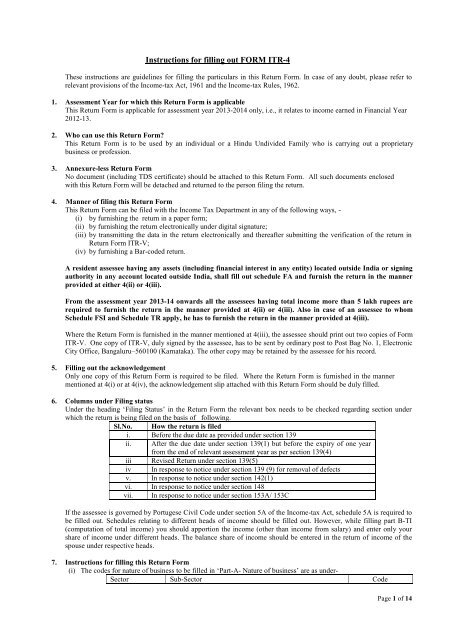

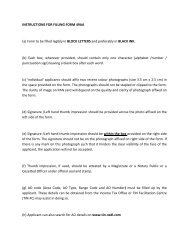
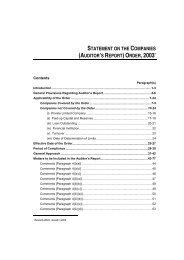
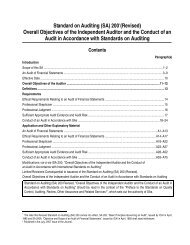
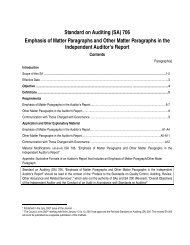
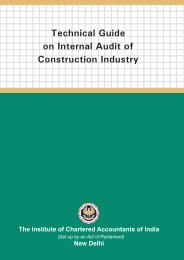
![FORM 1 [See sub-rule (1) of rule 3] FORM OF ... - CAalley.com](https://img.yumpu.com/49905825/1/190x245/form-1-see-sub-rule-1-of-rule-3-form-of-caalleycom.jpg?quality=85)
